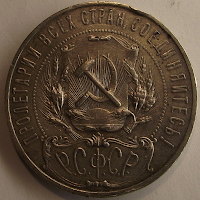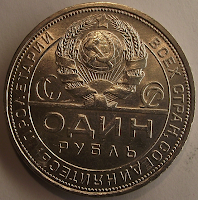In 1917 the Great October Socialist
Revolution had happened which handed power to the workers and peasants. The
Bolshevik Party did not repeat the fatal mistake of the Paris Commune 1871 has
left the bank in the hands of the bourgeoisie. One of the first public
institutions engaged people in revolt was the Central State Bank in Petrograd . In December 27, 1917 was made public decision of the Central
Executive Committee of the Council of Workers, Peasants and Soldiers' Deputies
on the nationalization of all banks in the country. The Soviet state has
inherited from the old regime completely ruined finances.
On June 1, 1918 to January 1, 1921 wages increased 24.5 times, while the
purchasing power of the ruble decreased 188 times. The real cost of the most
expensive banknote of 10 000 roubles was only 59 kopeeks.
After defeating the internal and external
enemies, the Soviet government immediately returned to the issue of monetary
reform. Already in March 1921, the People's Commissariat of Finance has decided
to start production of silver coins. In April Labor and Defense Council decided
to restore the Petrograd Mint. In the same year, 10, 15, 20, 50 kopeeks and the
ruble equal in quality corresponding to the nominal imperial Russia August 17, 1921 , Lenin saw the newly minted ruble,
recorded: "1921. Silver rouble save".
Rouble and 50 kopecks RSFSR were issued in
1921 -1922 years. 10, 15 and 20 kopeeks were issued in 1921 - 1923. All these coins
were not put into circulation in the years of their coinage due to the need to
create a cash reserve sufficient to meet the needs of the market. In November
13, 1922, speaking at the IV Congress of the Communist International, Lenin
raised the issue of strengthening the Soviet rouble: " I think you can consider the famous
Russian rouble, if only because the number of roubles now exceeds quadrillion. We
manage for a long time, and then permanently stabilize the ruble - so we won.
Then all these astronomical figures, all these trillions and quadrillions are
nothing. Then we can put our economy on a sound footing and on solid ground to
develop further".
In November 1922, the Soviet government
decided to mint gold coins. Following this decision in 1923 gold pieces
(chervonets) were produced and used (mainly for payments to other states).
Chervonets of 1923 corresponded to their content of pure gold before the
Revolution to 10 rubles. Drawing and lettering front 10 roubles were the same
as that of the silver coins of the RSFSR, on the reverse side portrayed peasant
were designated denomination ("one chervonets") and date. Markings were
by Slavic script.
Silver coins RSFSR 1921 -1923 years were put
into circulation in 1924. In the same year there was production of silver and
copper coins of the Union of Soviet Socialist Republics
Rouble minted only in 1924 and fifty kopeeks
(poltinnik) minted 1924-1927. They had a common type face: state emblem of the USSR
Examples of coins of this period you can purchase:
Rouble 1921 (11.5.2013, Sold for 450NIS, 126$)
Rouble 1922 (31.12.2013, Sold for 455$)
Rouble 1924






No comments:
Post a Comment